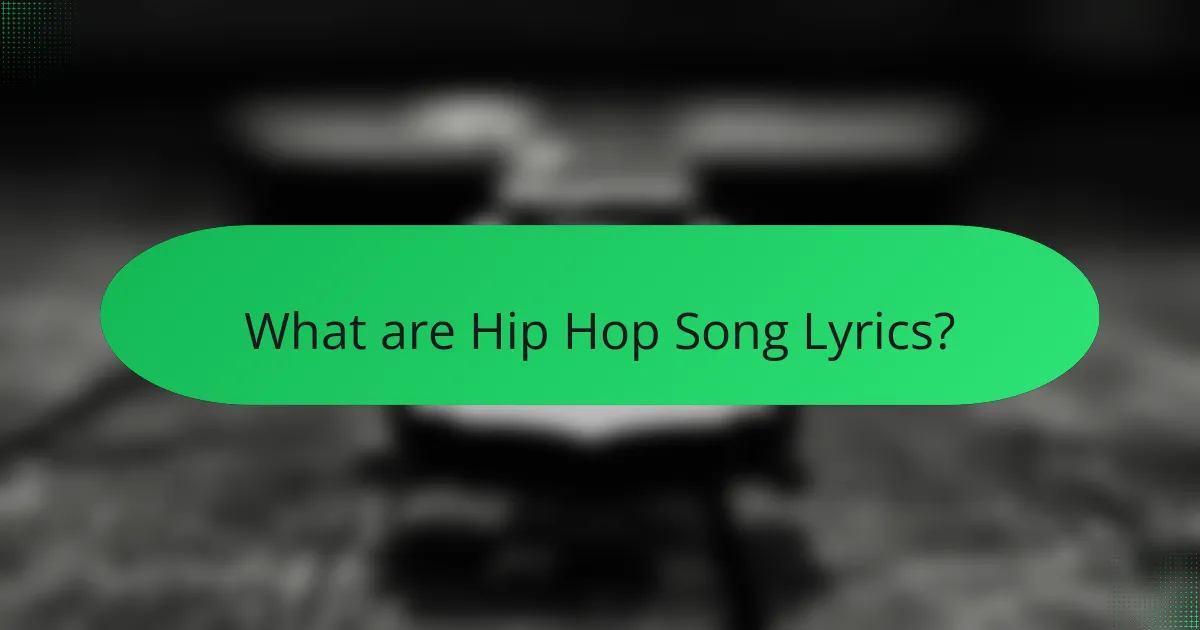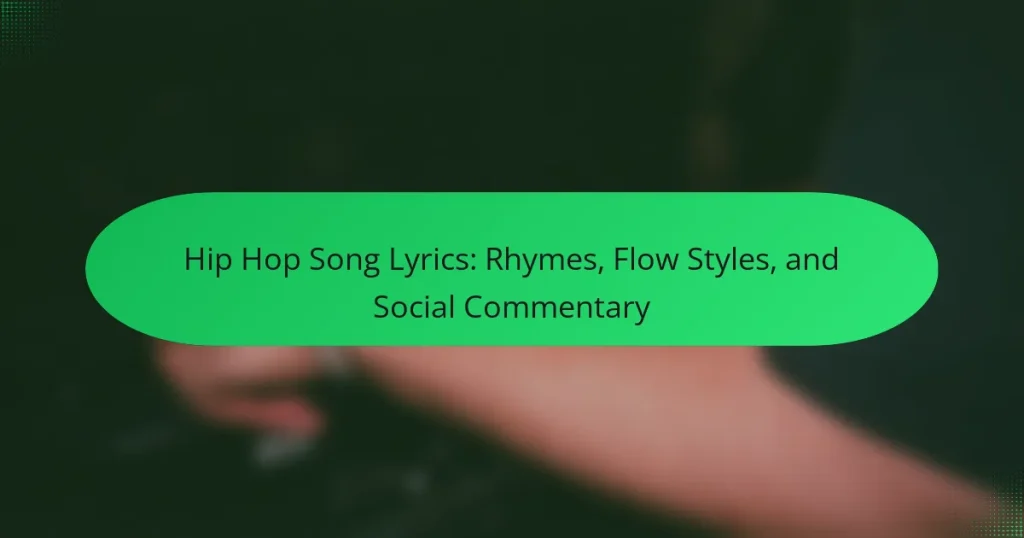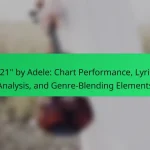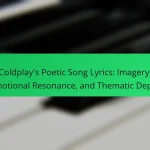Hip hop song lyrics are the textual components that accompany hip hop music, characterized by rhythmic and rhyming speech patterns. These lyrics often delve into personal experiences, social issues, and cultural commentary, incorporating storytelling elements that address themes such as struggle, identity, and resilience. The structure typically includes verses and choruses, with artists employing wordplay, metaphors, and similes to amplify their messages. The lyrical content plays a crucial role in defining the genre’s identity and impact, making it a significant aspect of hip hop culture.

What are Hip Hop Song Lyrics?
Hip hop song lyrics are the words that accompany hip hop music. They often feature rhythmic and rhyming speech patterns. These lyrics can express personal experiences, social issues, and cultural commentary. Hip hop lyrics frequently incorporate storytelling elements. They may address themes like struggle, identity, and resilience. The structure of hip hop lyrics varies, often including verses and choruses. Many artists use wordplay, metaphors, and similes to enhance their message. The lyrical content is integral to the genre’s identity and impact.
How do Hip Hop Song Lyrics differ from other musical genres?
Hip Hop song lyrics differ from other musical genres primarily in their focus on rhythm, wordplay, and social commentary. The lyrical structure often emphasizes complex rhyme schemes and a unique flow that can vary significantly from song to song. This genre frequently incorporates storytelling elements that reflect personal experiences, societal issues, and cultural narratives.
Unlike pop or rock, which may prioritize melody and harmony, Hip Hop places a stronger emphasis on the lyrical message and delivery. The use of slang and regional dialects is common, adding authenticity and relatability to the lyrics. Additionally, Hip Hop often serves as a platform for political and social critique, addressing topics like inequality and systemic oppression.
For example, artists like Kendrick Lamar and Nas are known for their thought-provoking lyrics that challenge the status quo. This distinct approach sets Hip Hop apart from genres that may not prioritize lyrical depth or social relevance to the same extent.
What unique characteristics define Hip Hop Song Lyrics?
Hip Hop song lyrics are defined by their rhythmic flow, intricate rhyme schemes, and strong social commentary. The use of wordplay and metaphors is prevalent in these lyrics. They often reflect personal experiences and cultural narratives. Additionally, Hip Hop lyrics frequently address social issues like inequality and injustice. The storytelling aspect is crucial, providing listeners with vivid imagery and emotional depth. Unique vocal delivery styles, such as syncopation and cadences, enhance the overall impact. Collaborations and call-and-response techniques further enrich the lyrical experience. These characteristics collectively contribute to the genre’s distinct identity in music.
How do cultural influences shape Hip Hop Song Lyrics?
Cultural influences shape Hip Hop song lyrics by reflecting the social, political, and economic contexts of communities. These lyrics often address issues like systemic racism, poverty, and identity. For instance, artists like Public Enemy and N.W.A. use their music to comment on police brutality and social injustice. The diverse backgrounds of artists contribute to a rich tapestry of themes and narratives. Regional influences also play a role, as seen in the distinct sounds and styles of East Coast versus West Coast Hip Hop. Additionally, cultural references in lyrics can draw from historical events, personal experiences, and community traditions. This interplay between culture and lyrics creates a powerful form of expression that resonates with listeners.
What role do Rhymes play in Hip Hop Song Lyrics?
Rhymes are fundamental in hip hop song lyrics as they enhance the musicality and flow of the verses. They create a rhythmic structure that makes the lyrics more engaging. Rhymes also aid in memorability, allowing listeners to recall the lyrics easily. Additionally, they contribute to the artistry of wordplay, showcasing the rapper’s skill and creativity. Historical examples, such as the use of internal rhymes in artists like Nas, demonstrate their effectiveness in storytelling. Rhymes can also emphasize themes and emotions, adding depth to the message conveyed. Overall, they play a crucial role in defining the genre’s unique style and cultural significance.
What are the different types of rhymes used in Hip Hop?
The different types of rhymes used in Hip Hop include end rhymes, internal rhymes, slant rhymes, and multisyllabic rhymes. End rhymes occur at the end of lines and create a sense of closure. Internal rhymes happen within a single line, enhancing the rhythm and flow. Slant rhymes involve similar but not identical sounds, adding complexity to the lyrics. Multisyllabic rhymes consist of multiple syllables that rhyme, showcasing lyrical skill and creativity. These rhyme types contribute to the overall artistry and expression in Hip Hop music.
How do rhymes enhance the overall impact of a song?
Rhymes enhance the overall impact of a song by creating memorable patterns and improving lyrical flow. They make the lyrics catchy and easier to remember. This memorability increases listener engagement and retention. Rhymes also contribute to the song’s rhythm and musicality. They help establish a consistent beat and enhance the overall listening experience. Research shows that songs with effective rhyme schemes are more likely to be replayed. A study by the University of Southern California found that listeners respond positively to rhythmic and rhyming structures in music.
How is Flow defined in Hip Hop Song Lyrics?
Flow in hip hop song lyrics refers to the rhythmic and melodic delivery of lyrics. It encompasses the timing, pace, and smoothness of a rapper’s performance. Flow is essential for maintaining the song’s cadence and engaging the listener. Different artists exhibit unique flows, influenced by their style and the beat. For instance, some may use rapid-fire delivery, while others may prefer a laid-back approach. The complexity of flow can include variations in rhyme schemes and syllable counts. Many acclaimed hip hop artists, like Nas and Kendrick Lamar, are known for their distinctive flows. Their techniques contribute to the overall artistry and impact of their lyrics.
What are the various flow styles found in Hip Hop?
Various flow styles found in Hip Hop include the triplet flow, straight flow, and syncopated flow. The triplet flow features a rapid-fire delivery with three syllables per beat. This style is popularized by artists like Migos and Future. The straight flow follows a more traditional rhythmic pattern with even syllable distribution. It is often used by artists such as Nas and Jay-Z. The syncopated flow emphasizes off-beat rhythms, creating a unique and dynamic sound. This style can be heard in the works of artists like Kendrick Lamar. Each flow style contributes to the diversity and complexity of Hip Hop music.
How does flow affect the delivery of lyrics?
Flow significantly affects the delivery of lyrics in hip hop. Flow refers to the rhythm and pace at which a rapper delivers their lyrics. A well-executed flow enhances the overall musicality of a track. It allows for better integration with the beat and instrumental elements. This synchronization creates a more engaging listening experience.
Moreover, flow can convey emotional nuances in the lyrics. Different flow patterns can evoke various feelings and moods. For example, a rapid-fire flow may convey urgency or excitement. In contrast, a slower flow can create a reflective or somber tone.
Research indicates that flow is crucial for maintaining listener interest. A study by the University of Southern California found that variations in flow keep audiences engaged. This engagement is essential for the success of hip hop songs. Thus, flow is a vital component in the effective delivery of lyrics.
What is the significance of Social Commentary in Hip Hop Song Lyrics?
Social commentary in hip hop song lyrics serves as a powerful tool for addressing social issues. It allows artists to express their views on topics like racism, poverty, and inequality. This genre often reflects the struggles and experiences of marginalized communities. For instance, songs like “Fight the Power” by Public Enemy highlight systemic oppression. Similarly, Kendrick Lamar’s “Alright” became an anthem during the Black Lives Matter movement. These examples demonstrate how hip hop can provoke thought and inspire change. Social commentary thus plays a crucial role in raising awareness and fostering dialogue.
How do artists use lyrics to address social issues?
Artists use lyrics to address social issues by incorporating personal experiences and societal observations. They often highlight injustices, inequalities, and struggles within their communities. For example, hip hop artists like Kendrick Lamar and Public Enemy tackle topics such as racial discrimination and police brutality. Their lyrics serve as a platform for raising awareness and prompting discussions. Historical events and cultural contexts frequently inform their messages. This approach resonates with listeners, fostering a sense of solidarity and empowerment. Studies show that music can influence social movements and inspire change. For instance, the Civil Rights Movement utilized songs to unify and mobilize supporters.
What impact do socially conscious lyrics have on listeners?
Socially conscious lyrics have a profound impact on listeners. They raise awareness about social issues such as inequality and injustice. This genre of lyrics often encourages critical thinking and reflection. Research shows that listeners who engage with socially conscious music report increased empathy. A study published in the Journal of Music and Social Behavior found that exposure to these lyrics can motivate social activism. Additionally, socially conscious lyrics can foster a sense of community among listeners. They create a shared understanding of societal challenges. Overall, these lyrics inspire dialogue and action regarding pressing social concerns.
How do Rhymes and Flow interact in Hip Hop Song Lyrics?
Rhymes and flow interact in hip hop song lyrics by creating a rhythmic and melodic structure. Rhymes provide the sonic elements that enhance memorability and engagement. Flow refers to the delivery of lyrics over a beat, influencing the pace and emotional impact. A strong flow can accentuate rhymes, making them more effective. Artists often manipulate flow to emphasize specific rhymes, creating tension or resolution. This interplay allows for intricate patterns that captivate listeners. For example, Eminem’s use of internal rhymes demonstrates how flow can elevate lyrical complexity. The combination of rhymes and flow is essential for effective storytelling in hip hop.
What techniques do artists use to blend rhymes and flow effectively?
Artists use techniques such as internal rhymes, multisyllabic rhymes, and syncopation to blend rhymes and flow effectively. Internal rhymes occur when rhyming words are placed within a single line, creating a rhythmic complexity. Multisyllabic rhymes involve rhyming multiple syllables instead of just one, enhancing lyrical richness. Syncopation refers to placing emphasis on unexpected beats, allowing for dynamic flow variations. Additionally, artists often utilize assonance and consonance to create subtle rhyme patterns that enhance the overall sound. These techniques contribute to a seamless integration of lyrics and rhythm, making the delivery more engaging. Historical examples include Nas and Eminem, who are known for their intricate rhyme schemes and flow mastery.
How does the interaction of rhymes and flow contribute to the song’s message?
The interaction of rhymes and flow enhances the song’s message by creating a rhythmic structure that emphasizes key themes. Rhymes provide a memorable quality, making the lyrics easier to recall. Flow refers to the delivery and pace of the lyrics, influencing how the message is perceived. When rhymes align with the flow, they can intensify emotional impact. For example, a rapid flow with internal rhymes can convey urgency. Conversely, a slow flow with end rhymes can evoke reflection. This synergy can reinforce the song’s narrative, making the message more compelling. Studies show that songs with strong rhythmic elements are more likely to engage listeners and convey complex ideas effectively.
What are some notable examples of Hip Hop Song Lyrics that exemplify these elements?
Notable examples of Hip Hop song lyrics that exemplify rhymes, flow styles, and social commentary include “Fight the Power” by Public Enemy. This song features powerful lyrics addressing racial inequality and social justice. Another example is “Alright” by Kendrick Lamar, which uses a hopeful message amidst struggles for the Black community. “The Message” by Grandmaster Flash and the Furious Five is significant for its vivid storytelling about urban life challenges. “Changes” by 2Pac tackles issues like racism and poverty through poignant lyrics. Each of these songs showcases the core elements of hip hop through their impactful lyrics and unique flow styles.
Which songs are considered classics for their lyrical content?
Songs considered classics for their lyrical content include “The Message” by Grandmaster Flash and the Furious Five. This song is renowned for its vivid portrayal of urban life and social issues. Another classic is “Fight the Power” by Public Enemy, which addresses racial inequality and empowerment. “Juicy” by The Notorious B.I.G. is celebrated for its autobiographical storytelling and cultural impact. “Dear Mama” by 2Pac is recognized for its heartfelt tribute to mothers and personal struggles. These songs are often cited in discussions about influential hip hop lyrics due to their depth and relevance.
How have these examples influenced the genre as a whole?
These examples have significantly influenced the hip hop genre by shaping lyrical content and flow techniques. Artists have adopted innovative rhyme schemes that elevate the complexity of lyrics. The use of social commentary has become a hallmark, addressing issues like inequality and systemic injustice. This shift encourages deeper engagement from listeners. Moreover, the blending of various flow styles has expanded the genre’s musical diversity. These changes have led to a broader acceptance of hip hop in mainstream music. Consequently, the genre has evolved to include a wider array of influences and collaborations. This evolution reflects the dynamic nature of hip hop as a cultural movement.
What tips can aspiring lyricists use to improve their Hip Hop Song Lyrics?
Aspiring lyricists can improve their Hip Hop song lyrics by practicing regularly. Writing daily helps develop a unique style and voice. Analyzing successful artists provides insight into effective techniques. Listening to various beats enhances understanding of rhythm and flow. Experimenting with different rhyme schemes adds complexity to lyrics. Collaborating with other artists fosters creativity and new ideas. Seeking feedback from peers can identify strengths and areas for improvement. Lastly, performing live builds confidence and hones delivery skills.
Hip hop song lyrics serve as the foundational element of the genre, characterized by rhythmic patterns, intricate rhyme schemes, and strong social commentary. The article explores how these lyrics differ from other musical genres, emphasizing their storytelling aspects and cultural influences. It delves into the significance of rhymes and flow in enhancing lyrical delivery and emotional impact, while also highlighting notable examples of socially conscious lyrics that address pressing societal issues. Additionally, tips for aspiring lyricists are provided to help improve their writing skills and lyrical creativity.


